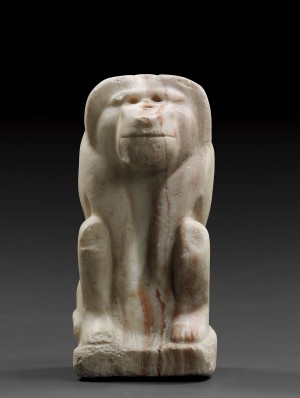The Great Dawning: The Birth of Ancient Egyptian Art
Inarguably, the most dramatic of the large mammals, this Hamadryas baboon, a dweller in the arid desert cliffs, sits quietly. But he watches. He waits. The rounded cavities that form his eyes lend a remarkable intensity that would have been missing if the same feature had been traditionally inlaid. Circle him slowly until the natural veining of the travertine stone is revealed, visually lengthening the sloping back. A carving at the base, identifying Narmer the last Pre-Dynastic ruler (3100 B.C.) is believed to be a dedication. Perhaps it is meant for the early baboon deity known as “The Great White One” (or the moon). Move on to other inhabitants of this room and his gleaming white image remains with you.
The Human Figure into Art
One of the real keystones of this exhibit are the depictions of the human figure in two forms: realistic figurines showing the entire body in bone or ivory or abstracted forms in clay, often lacking limbs and possessing beak-like faces. Ms. Patch explained the vital importance that the nose played to these early peoples, a vital connection to the very principle of life itself. Such beliefs were of supernatural importance; long before even the sun god Re was created. The nose was a symbol of clairvoyance, and powders were made of animal snouts to establish contact with the spirits in later African cultures. If breathing was elemental to these forms, so was the ability to stand. It was thought likely that they were used in various rituals, their legs often pointed and easily held for this purpose.
Whatever the scope or length of your visit, there are three women depicted here you must not miss.
The oldest realistic figurine — and one of the most exquisitely carved — is The Badarian Woman (4400-3800 B.C.). She reveals breasts and a pubis, while men of the same period often wore prominent penis sheaths. These representations, however miniscule they appear to the eye, carry a power equal to the baboon carving. A tiny dwarf figure is only one of several that have been found in early tombs, and it is assumed by the style and costume of their depiction, they were often part of a royal entourage.
A certain roughness in execution is sometimes found in early clay craftsmanship, so encountering the rare gracefulness and beauty of the Celebrant figurine, the “Bird Woman” (3650 B.C.) is a sight to behold. Her nickname is a misnomer, as the sculptured head simply emphasizes the nose and its purpose. The smooth line of her body is accentuated from head to feet. Later Dynastic sculptures may impress, but not surpass, her perfection.
The Standing Woman (The Lady of Brussels) from the Musees Royaux d’Art et d’Histoire in Brussels, and the last of the three, is an almost life-size statue created late enough in the Early Dynastic Period (2695-2649) that she resembles later Egyptian statuary. She wears a V-necked dress but her neck is shorter and more similar to earlier forms. With her left arm bent across her chest, it’s an indication that these artisans were not yet working to a pure canonical form. Both the Brussels Museum and the Met have recently restored her to a more likely version of her original form.
Another example of statuary that has a magnetic hold over the viewer is that of a human captive, the Door socket in the form of a bound captive (3100-2900 B.C.). Unlike many other examples, this black dolerite base had a practical purpose. A long pole was slotted into sockets that allowed a temple door to rotate open and closed. The man’s subjugation is total. Each time the door opened, the post rotated in the prisoner’s back. This gruesome but beautifully rendered sculpture showed all visitors to the temple that any attack against Egypt was futile.
The Met has a world-class collection of Egyptian art, covering thirty-nine rooms, with an inventory of over 26,000 objects in the Lila Acheson Wallace wing. The wonders of the ancient world await every age in those rooms alone. But it can envelop the sensibilities. In The Dawn of Egyptian Art, you can envelop and embrace the magic of the exhibit.
The Dawn of Egyptian Art runs from April 10 through August 5, 2012. The Metropolitan Museum of Art is located at 1000 Fifth Avenue, New York, NY 10028. For information, please visit www.metmuseum.org or call 212-535-7710.

